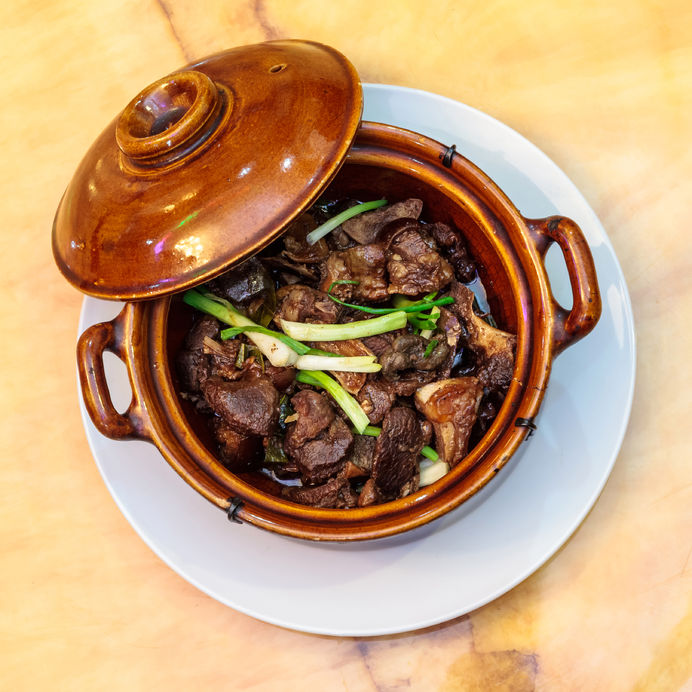Continuing to Think Outside the Box for Nutrition Inspiration
Last week, we began our quest to discover new recipes. Rather than resorting to tried-and-true “North American” dishes, or “Americanized” versions of cultural staples (tacos, hummus, pasta, etc), I wanted to dive deeper into the unique foods that provided comfort as well as nutritional benefits to cultures around the world. This week, I’m stepping a bit farther outside of the box than I did last week. Some of these foods might seem strange to you, but that’s just because we’re not accustomed to them. Just because you haven’t tried something, doesn’t make it any less tasty or nutritious. Honestly…if I didn’t tell you what these ingredients were, but instead just fed them to you, I bet that you’d devour them and ask for more with the assumption that they was made from common staples (beef, chicken, pork, etc). Open your mind and expand your palate.
Goat…the “other” red meat?
Ok, I admit that if someone offered me goat, my first reaction would be to immediately decline. When you think about it, how is goat any less gross than pig? Really. Believe it or not, goats are picky eaters. They are pasture-raised on shrubs and weeds. Goat are among the earliest domesticated animals. In the U.S., we are actually the weird ones by not consuming them, as goat is consumed by more than 70 percent of the world’s population. It is most popular in North African and Middle Eastern nations and is also common in the Caribbean, Southeast Asia and developing tropical countries.
Goat milk is commonly found in regular grocery stores, as is goat cheese, but their meat is valuable as well. Spanish goats and South African Boer goats are known to have superior flavor. Tenderness of meat and flavor are also impacted by the age and size of the goat. According to Food and Nutrition Magazine, “The meat from yearling or younger goats is very lean because kid goats do not store much body fat, while older goats yield a less tender yet juicier and earthier-tasting meat. Younger and smaller goats have a milder flavor, often described as a cross between lamb and beef.”

Goat Stew
Goat meat is an extremely lean protein. As a result, it is best when braised, stewed or cooked in a pressure cooker with a liquid such as broth, wine, or milk. This breaks down the proteins, yielding a much juicier and tender end product.
Goat meat is lower in total fat, saturated fat, calories and cholesterol compared to beef, pork and lamb. A 3-ounce serving provides 122 calories, 2.6 grams fat, 0.8 grams saturated fat and 64 milligrams cholesterol. In addition to being an excellent source of protein, goat provides zinc, iron, potassium and vitamin B12, and is low in sodium.
If you want to give goat a try, the cost-point is similar to lamb or mutton. Fresh goat meat can be found in ethnic markets or at specialty butchers. You might even find it on U.S. menus. If you see chevon, that indicates an adult goat. For young goats, you’ll see cabrito, capretto or kid.
Food and Nutrition Magazine states that, “In Latin dishes, it is often rubbed with chilies and spices and slow-roasted, or stewed for Mexican birria. Indian cooking uses goat meat in curries, biryanis and yogurt-thickened dishes. Greek and Southern Italian celebrations may include roasted baby goat, while curried goat is a Caribbean favorite.” You can substitute goat for any protein (especially lamb) whether you’re grilling, making a stew, or a curry. Go ahead, be brave!
Here is a recipe for Kabritu Stobá (Caribbean Goat Stew )
Recipe developed by Jessie Erwin, RD, LDN
Ingredients
1 pound boneless goat meat, chopped into 1-inch cubes
2 tablespoons canola oil
1 medium onion, chopped
3 medium carrots, peeled and sliced
3 cloves garlic, minced
1/4 cup tomato paste
2 cups beef or chicken stock
1/4 cup white wine or white vinegar
1/4 teaspoon ground nutmeg
1 teaspoon sugar
1/2 teaspoon red pepper flakes
Juice from 1 lime
2 medium tomatoes, chopped
Salt and pepper to taste
Chopped parsley (optional)
Directions
- Heat canola oil in a large skillet over medium heat, then add goat and brown for 5 minutes, turning cubes frequently.
- Add onions and carrots and sauté for 5 minutes or until carrots soften.
- Stir in garlic and cook for 30 seconds.
- Add tomato paste, stock, wine, nutmeg, sugar and red pepper flakes.
- Bring stew to a boil, then reduce heat, cover and simmer on low for 2 hours, adding more water or stock if necessary to keep the stew moist.
- Remove lid and add tomatoes and lime juice. Continue simmering for 15 to 20 minutes or until stew reaches desired consistency.
- Add salt and pepper to taste. Ladle into serving bowls and sprinkle with chopped parsley, if desired. Serves 4.
Nutrition Information
Serving size : 1 cup
Calories 312; Total fat 11g; Sat. fat 2g; Chol . 85mg; Sodium 515mg; Carb . 18g; Fiber 4g; Sugars 11g; Protein 36g; Potassium 1,248mg; Phosphorous 308mg
Insects…the hottest protein?
Again, the U.S. is behind the trend. In this case, it’s regarding not consuming insects. According to the Food and Agriculture Organizations of the United Nations (FAO), “From ants to beetle larvae – eaten by tribes in Africa and Australia as part of their subsistence diets – to the popular, crispy-fried locusts and beetles enjoyed in Thailand, it is estimated that insect-eating is practiced regularly by at least 2 billion people worldwide.” Insect consumption is proposed to be a sustainable way that could possibly end world hunger. This is due to many factors which include:
- Variety! There are estimated to be 6-10 million different species of insects.
- Raising insects would produce far less greenhouse gasses than conventionally raised beef, pork, or chicken.
- Due to the inexpensive nature of insect farming, it could be a source of income for poorer countries.
- Compared to conventionally raised beef, pork, or chicken, insects pose a far lower risk of transmitted diseases to humans.
- Compared to pigs and chicken, crickets need 12 times less feed to convert into the same amount of protein.
- According to , Gene DeFoliart, a professor emeritus of entomology at the University of Wisconsin-Madison, “Insect farming is arguably much more efficient than cattle production. One hundred pounds (45 kilograms) of feed produces 10 pounds (4.5 kilograms) of beef, while the same amount of feed yields 45 pounds (20 kilograms) of cricket.”
Okay. Sustainability aside, there has to be another reason why so many countries consider insects an integral part of their diet. Are you ready for it? It is an excellent source of nutrients!!
- Protein: To put things in perspective, hamburger meat is about 18 percent protein and 18 percent fat. On the other hand, cooked grasshopper contains up to 60 percent protein with just 6 percent fat.
- Healthy fats: Insects are an excellent source of unsaturated fats. In fact, some species rival fish in their omega-3 content.
- Other nutrients: insects provide good sources of calcium ( for healthy bones), iron (for production of hemoglobin and red blood cells), zinc (for immune function and DNA synthesis), and selenium (which is beneficial for thyroid function), B-Vitamins (for energy)
Surprisingly, insects taste good too! According to Dave Gracer, Advisor for Insects Are Food, “ Dry-toasted cricket tastes like sunflower seeds; katydid like toasted avocado; palm grub like bacon soup with a chewy, sweet finish. Weaver ant pupae have practically no flavor, while the meat of the giant water bug is, astonishingly, like a salty, fruity, flowery Jolly Rancher.” And there you have it; an insect flavor for every palate desire.
If you’re feeling adventurous, or rather, have the urge to “fit in” (everyone else is doing it!), head over to your local pet store. Any store that sells reptile foods should carry crickets and/or mealworms. Additionally, insects are available for purchase from online vendors. Maybe you’re not ready to have toasted crickets as a snack, and I’ll admit—I’m not quite ready for that either. There is a much easier way to incorporate insect protein into your diet. Exo (exoprotein.com) sells protein bars that utilize cricket protein. They also just so happen to be grain, gluten, and dairy free! You can also swap out your standard protein powder for cricket powder! Find various types on amazon.com (see link in credits).
In the beginning, I warned you that I was going to discuss some strange foods. It’s important to remember that it’s really all a matter of perspective. What is strange to us is common place in the majority of the world! Oddities aside, both goat and insects boast a pretty remarkable nutrient profile. Break out of your standard food routine. Maybe we could learn something from food culture around the globe. ☺
Resources:
http://articles.mercola.com/sites/articles/archive/2013/06/01/eating-insects.aspx
http://www.foodandnutrition.org/May-June-2014/Why-Goat-Could-be-Coming-to-Table-Near-You/
http://www.medicalnewstoday.com/articles/263176.php
https://www.nationalgeographic.com/culture/article/eating-bugs-cultural-cuisine











